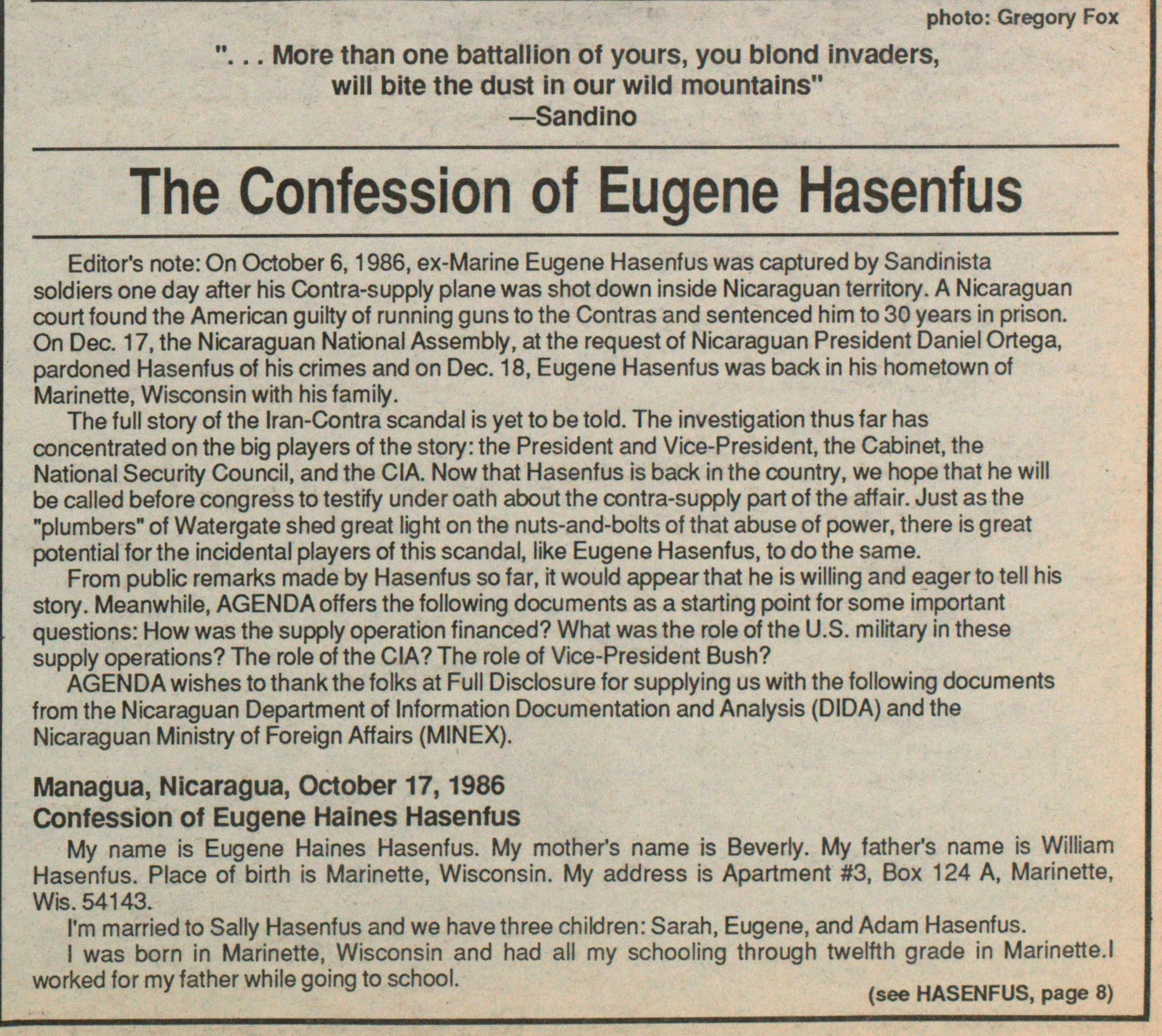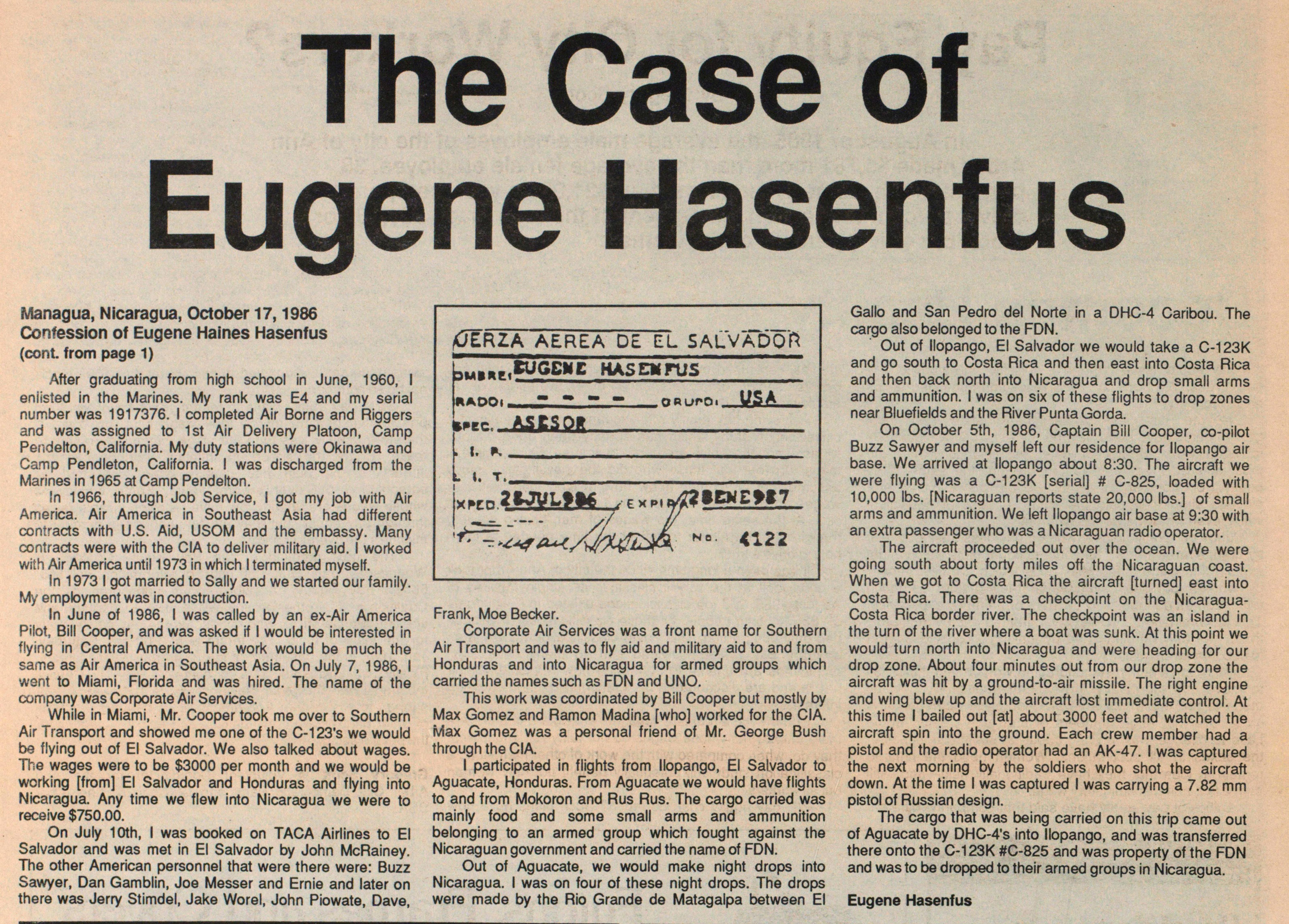The Confession Of Eugene Hasenfus


Editor's note: On October 6, 1986, ex-Marine Eugene Hasenfus was captured by Sandinista soldiers one day after his Contra-supply plane was shot down inside Nicaraguan territory. A Nicaraguan court found the American guilty of running guns to the Contras and sentenced him to 30 years in prison. On Dec. 17, the Nicaraguan National Assembly, at the request of Nicaraguan President Daniel Ortega, pardoned Hasenfus of his crimes and on Dec. 18, Eugene Hasenfus was back in his hometown of Marinette, Wisconsin with his family.
The full story of the Iran-Contra scandal is yet to be told. The investigation thus far has concentrated on the big players of the story: the President and Vice-President, the Cabinet, the National Security Council, and the CIA. Now that Hasenfus is back in the country, we hope that he will be called before congress to testify under oath about the contra-supply part of the affair. Just as the "plumbers" of Watergate shed great light on the nuts and bolts of that abuse of power, there is great potential for the incidental players of this scandal, like Eugene Hasenfus, to do the same.
From public remarks made by Hasenfus so far, it would appear that he is willing and eager to tell his story. Meanwhile, AGENDA offers the following documents as a starting point for some important questions: How was the supply operation financed? What was the role of the U.S. military in these supply operations? The role of the CIA? The role of Vice-President Bush?
AGENDA wishes to thank the folks at Full Disclosure for supplying us with the following documents from the Nicaraguan Department of Information Documentation and Analysis (DIDA) and the Nicaraguan Ministry of Foreign Affairs (MINEX).
Managua, Nicaragua, October 17, 1986
Confession of Eugene Haines Hasenfus
My name is Eugene Haines Hasenfus. My mother's name is Beverly. My father's name is William Hasenfus. Place of birth is Marinette, Wisconsin. My address is Apartment #3, Box 124 A, Marinette, Wis. 54143.
I'm married to Sally Hasenfus and we have three children: Sarah, Eugene, and Adam Hasenfus.
I was born in Marinette, Wisconsin, and had all my schooling through twelfth grade in Marinette. l worked for my father while going to school.
After graduating from high school in June 1960, I enlisted in the Marines. My rank was E4 and my serial number was 1917376. I completed Air Borne and Riggers and was assigned to the 1st Air Delivery Platoon, Camp Pendelton, California. My duty stations were Okinawa and Camp Pendleton, California. I was discharged from the Marines in 1965 at Camp Pendelton. In 1966, through Job Service, I got my job with Air America. Air America in Southeast Asia had different contracts with U.S. Aid, USOM, and the embassy. Many contracts were with the CIA to deliver military aid. I worked with Air America until 1973 in which I terminated myself.
In 1973 I got married to Sally and we started our family. My employment was in construction.
In June of 1986, I was called by an ex-Air America Pilot, Bill Cooper, and was asked if I would be interested in flying in Central America. The work would be much the same as Air America in Southeast Asia. On July 7, 1986, I went to Miami, Florida, and was hired. The name of the company was Corporate Air Services.
While in Miami, Mr. Cooper took me over to Southern Air Transport and showed me one of the C-123s we would be flying out of El Salvador. We also talked about wages. The wages were to be $3000 per month and we would be working [from] El Salvador and Honduras and flying into Nicaragua. Any time we flew into Nicaragua we were to receive $750.00.
On July 10th, I was booked on TACA Airlines to El Salvador and was met in El Salvador by John McRainey. The other American personnel that were there were: Buzz Sawyer, Dan Gamblin, Joe Messer, and Ernie and later on, there was Jerry Stimdel, Jake Worel, John Piowate, Dave, Frank, and Moe Becker.
Corporate Air Services was a front name for Southern Air Transport and was to fly aid and military aid to and from Honduras and into Nicaragua for armed groups which carried the names such as FDN and UNO.
This work was coordinated by Bill Cooper but mostly by Max Gómez and Ramón Madina [who] worked for the CIA. Max Gómez was a personal friend of Mr. George Bush through the CIA. I participated in flights from Llopango, El Salvador to Aguacate, Honduras. From Aguacate we would have flights to and from Mokoron and Rus Rus. The cargo carried was mainly food and some small arms and ammunition belonging to an armed group which fought against the Nicaraguan government and carried the name of FDN.
Out of Aguacate, we would make night drops into Nicaragua. I was on four of these night drops. The drops were made by the Rio Grande de Matagalpa between El Gallo and San Pedro del Norte in a DHC-4 Caribou. The cargo also belonged to the FDN.
Out of Ilopango, El Salvador we would take a C-123K and go south to Costa Rica and then east into Costa Rica, and then back north into Nicaragua and drop small arms and ammunition. I was on six of these flights to drop zones near Bluefields and the River Punta Gorda.
On October 5th, 1986, Captain Bill Cooper, co-pilot Buzz Sawyer and myself left our residence for Ilopango air base. We arrived at llopango about 8:30. The aircraft we were flying was a C-123K [serial] # C-825, loaded with 10,000 Ibs. [Nicaraguan reports state 20,000 Ibs.] of small arms and ammunition. We left llopango air base at 9:30 with an extra passenger who was a Nicaraguan radio operator.
The aircraft proceeded out over the ocean. We were going south about forty miles off the Nicaraguan coast. When we got to Costa Rica the aircraft [turned] east into Costa Rica. There was a checkpoint on the Nicaragua/Costa Rica border river. The checkpoint was an island in the turn of the river where a boat was sunk. At this point, we would turn north into Nicaragua and were heading for our drop zone. About four minutes out from our drop zone the aircraft was hit by a ground-to-air missile. The right engine and wing blew up and the aircraft lost immediate control. At this time I bailed out [at] about 3000 feet and watched the aircraft spin into the ground. Each crew member had a pistol and the radio operator had an AK-47. I was captured the next morning by the soldiers who shot the aircraft down. At the time I was captured I was carrying a 7.82 mm pistol of Russian design.
The cargo that was being carried on this trip came out of Aguacate by DHC-4s into llopango, and was transferred there onto the C-123K #C-825 and was property of the FDN and was to be dropped to their armed groups in Nicaragua.
Eugene Hasenfus
Article
Subjects
Nicaragua
Sandinista
Nicaraguan Resistance (Contras)
Iran-Contra Affair
Nicaraguan Department of Information Documentation and Analysis
Nicaraguan Ministry of Foreign Affairs
U.S. Marines
Airplane Pilots
Corporate Air Services
Southern Air Transport
Old News
Agenda
Eugene Hasenfus
Daniel Ortega
Beverly Hasenfus
William Hasenfus
Sally Hafenfus
Sarah Hasenfus
Adam Hasenfus
Eugene Hasenfus Jr
Bill Cooper
John McRainey
Buzz Sawyer
Dan Gamblin
Joe Messer
Jerry Stimdel
Jake Worel
John Piowate
Moe Becker
Max Gomez
Ramon Madina
George Bush